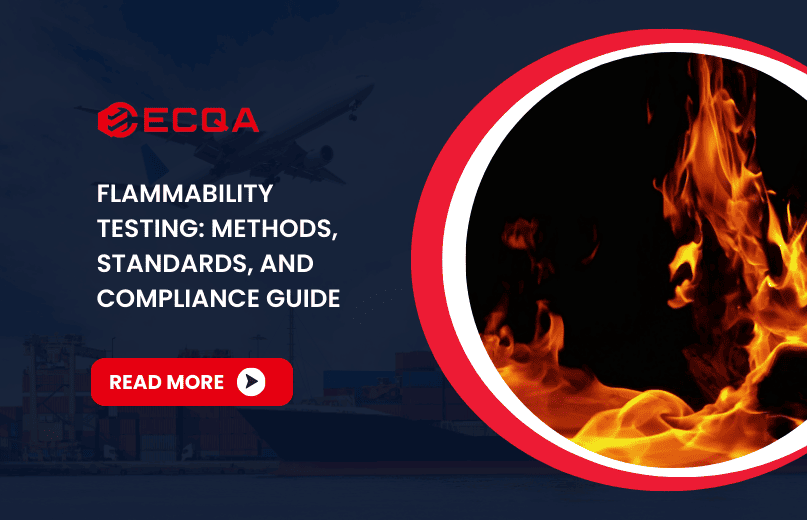
Flammability Testing: Standards, Methods, and Compliance Guide
Flammability testing is a process used to determine how easily materials ignite, how quickly flames spread, and how long materials continue to burn after ignition sources are removed. It is a fundamental requirement in product safety, ensuring that goods meet regulatory standards and protect end-users from fire-related hazards.
Across industries such as textiles, electronics, automotive, and construction, flammability testing helps manufacturers verify that their products comply with legal regulations and industry benchmarks. Without such testing, products may face recalls, import restrictions, or liability claims.

Why Flammability Testing Is Critical for Product Safety
Fire safety remains one of the most pressing concerns for manufacturers, regulators, and consumers. Products that do not undergo proper flammability testing may present hidden risks, exposing users to potentially life-threatening situations.
The significance of flammability testing can be understood through three primary dimensions:
Human Safety
Materials with poor flame resistance can accelerate fire spread. For instance, untreated upholstery or garments made from flammable fabrics can ignite rapidly, giving occupants little time to react.
Regulatory Compliance
Many regions enforce strict laws requiring manufacturers to meet specific flammability standards. Non-compliance can lead to rejected shipments, product recalls, and significant financial losses.
Brand Protection
Beyond compliance, companies use flammability testing to safeguard brand reputation. Demonstrating that a product has passed recognized testing standards signals reliability and commitment to consumer safety.
Common Flammability Testing Standards
Different industries and regions rely on established standards to regulate flammability performance. These standards ensure consistent testing procedures and comparable results worldwide.
ASTM Standards
The American Society for Testing and Materials (ASTM) develops widely used fire safety protocols. Some key examples include:
- ASTM D6413 – Standard Test Method for Flame Resistance of Textiles
- ASTM E84 – Surface Burning Characteristics of Building Materials
- ASTM D2863 – Measuring the Oxygen Index of Plastics
ASTM methods are prevalent in textiles, plastics, and building materials industries.
ISO Standards
The International Organization for Standardization (ISO) provides global frameworks that harmonize testing methods across regions. Notable standards include:
- ISO 15025 – Protective Clothing, Flame Spread Test
- ISO 5660 – Cone Calorimeter Test for Heat Release
- ISO 4589 – Determination of Burning Behavior by Oxygen Index
ISO standards are widely accepted in international trade and applied across multiple product categories.
UL Standards
Underwriters Laboratories (UL) standards are particularly critical for electrical and electronic components. The most recognized test is:
- UL 94 – Tests the flammability of plastic materials, classifying them into categories such as V-0, V-1, and HB depending on burn time and dripping behavior
UL certifications are often mandatory for electrical goods entering the U.S. and global markets.
EN Standards
The European Norms (EN) provide standardized testing across the European Union. Examples include:
- EN 71-2 – Flammability of Toys
- EN 13501 – Fire Classification of Construction Products
- EN ISO 12952 – Ignitability of Bedding Items
These standards are legally enforceable in the EU and closely monitored by regulatory authorities.
Types of Flammability Tests
Different materials and product categories require specific flammability test methods. Each test evaluates distinct fire behavior characteristics.
Vertical Flame Test
Used primarily for textiles and plastics, this method measures how a vertically oriented sample reacts when exposed to a flame. It assesses ignition time, flame spread rate, and after-flame duration.
Horizontal Flame Test
Similar to the vertical method but performed with the sample placed horizontally. It is particularly common in automotive and consumer goods, where real-world conditions often resemble horizontal orientation.
Oxygen Index Test
This test determines the minimum concentration of oxygen required to sustain combustion of a material. A higher oxygen index indicates better flame resistance.
Cone Calorimeter Test
A highly analytical method that measures heat release rate, smoke production, and combustion gases. It provides comprehensive insights into how materials contribute to fire growth.
Radiant Panel Test
Used for flooring and building materials, this test evaluates flame spread under radiant heat conditions, simulating fire exposure in real environments.
Industry Applications of Flammability Testing
Textiles and Apparel
Garments, upholstery, and bedding must meet strict flame resistance requirements. For example, children’s sleepwear in the U.S. is regulated by the CPSC (Consumer Product Safety Commission) with defined flammability thresholds.
Electronics and Electrical Components
Cables, casings, and circuit boards must comply with UL 94 and IEC standards to minimize fire risks caused by overheating or electrical faults.
Automotive and Aerospace
Vehicles are subject to stringent regulations to prevent rapid fire spread. FMVSS 302 in the U.S. sets requirements for flammability of materials used in vehicle interiors.
Construction and Building Materials
Insulation, flooring, and wall coverings undergo tests such as ASTM E84 and EN 13501 to classify fire behavior and ensure compliance with local building codes.
Flammability testing is an essential safeguard that protects consumers, ensures legal compliance, and strengthens brand reliability across industries. Manufacturers should align with recognized standards, select appropriate test methods, and work with accredited laboratories to guarantee results that regulators accept.
The most effective next step is to identify the standards that apply to your product category and partner with a certified testing laboratory such as ECQA, which specializes in flammability testing across multiple industries.

 Request Free Sample Report
Request Free Sample Report